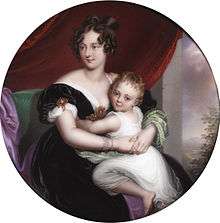George Agar-Ellis, 1st Baron Dover
George James Welbore Agar-Ellis, 1st Baron Dover PC FRS FSA (14 January 1797 – 10 July 1833) was a British politician and man of letters. He was briefly First Commissioner of Woods and Forests under Lord Grey between 1830 and 1831.
- For others named George Agar, see the George Agar navigation page
The Lord Dover | |
|---|---|
.jpg) | |
| First Commissioner of Woods and Forests | |
| In office 2 December 1830 – 7 February 1831 | |
| Monarch | William IV |
| Prime Minister | The Earl Grey |
| Preceded by | Viscount Lowther |
| Succeeded by | Viscount Duncannon |
| Personal details | |
| Born | George James Welbore Agar-Ellis 14 January 1797 |
| Died | 10 July 1833 (aged 36) |
| Nationality | British |
| Political party | Whig |
| Spouse(s) | Lady Georgiana Howard (d. 1860) |
| Alma mater | Christ Church, Oxford |
Background and education
Agar-Ellis was the only son of Henry Agar-Ellis, 2nd Viscount Clifden, and Lady Caroline, daughter of George Spencer, 4th Duke of Marlborough. He was educated at Westminster School and Christ Church, Oxford. He was elected a Fellow of both the Society of Antiquaries and Royal Society in 1816.[1]
Political career
Agar-Ellis was returned to Parliament for Heytesbury in 1818, a seat he held until 1820.[1][2] He afterwards represented Seaford between 1820 and 1826,[1][3] Ludgershall between 1826 and 1830[1][4] and Okehampton between 1830 and 1831.[1][5] He supported George Canning's motion in 1822 for a bill to relieve the disabilities of Roman Catholic peers, and consistently supported liberal principles. He took little interest in party politics but was a strong advocate of state support for the causes of literature and the fine arts.
In 1824 Agar-Ellis was the leading promoter of the grant of £57,000 for the purchase of John Julius Angerstein's collection of pictures, which formed the foundation of the National Gallery. On the formation of Lord Grey's Whig administration in November 1830, he was sworn of the Privy Council[6] and appointed First Commissioner of Woods and Forests.[7] However, he was forced to resign after two months due to bad health.
In June 1831, during his father's lifetime, Agar-Ellis was raised to the peerage as Baron Dover, of Dover in the County of Kent.[8] He was president of the Royal Society of Literature in 1832, a trustee of the British Museum and of the National Gallery, and a commissioner of public records.
Family

Lord Dover married his third cousin once removed Lady Georgiana Howard, daughter of George Howard, 6th Earl of Carlisle, in 1822. They had two sons, who became respectively the 3rd Viscount and 5th Viscount, and two daughters. He died on 10 July 1833, aged only 36, predeceasing his father by three years. Lady Dover died in March 1860.[1]
Works
Lord Dover's works were chiefly historical, and include:
- The True History of the State Prisoner, Commonly Called the Iron Mask (1826)
- Inquiries respecting the Character of Clarendon (1827)
- a Life of Frederick II. (1831)
He also edited the Ellis Correspondence (1829) and Walpole's Letters to Sir Horace Mann (1833).
References
- thepeerage.com George James Welbore Agar-Ellis, 1st Baron Dover
- "leighrayment.com House of Commons: Hertford to Honiton". Archived from the original on 11 October 2018. Retrieved 15 October 2009.
- "leighrayment.com House of Commons: Salisbury to Shaftesbury". Archived from the original on 14 September 2018. Retrieved 15 October 2009.
- "leighrayment.com House of Commons: London University to Lymington". Archived from the original on 3 December 2011. Retrieved 15 October 2009.
- "leighrayment.com House of Commons: Ochil to Oxford University". Archived from the original on 16 August 2011. Retrieved 15 October 2009.
- "No. 18748". The London Gazette. 23 November 1830. p. 2449.
- "No. 18753". The London Gazette. 3 December 1830. p. 2539.
- "No. 18814". The London Gazette. 17 June 1831. p. 1193.
- Attribution

External links
| Wikimedia Commons has media related to George Agar-Ellis, 1st Baron Dover. |
- Works by George Agar Ellis at Project Gutenberg
- Works by or about George Agar-Ellis, 1st Baron Dover at Internet Archive
- Hansard 1803–2005: contributions in Parliament by Mr George Agar-Ellis
| Parliament of the United Kingdom | ||
|---|---|---|
| Preceded by Samuel Hood Charles Duncombe |
Member of Parliament for Heytesbury 1818–1820 With: William Henry John Scott |
Succeeded by Edward Henry A'Court Charles Ashe A'Court |
| Preceded by Charles Ellis George Watson-Taylor |
Member of Parliament for Seaford 1820–1826 With: Charles Ellis |
Succeeded by John Fitzgerald Augustus Frederick Ellis |
| Preceded by Sandford Graham The Earl of Brecknock |
Member of Parliament for Ludgershall 1826–1830 With: Edward Thomas Foley |
Succeeded by Edward Thomas Foley Sir Sandford Graham, Bt |
| Preceded by Sir Compton Domvile, Bt Joseph Strutt |
Member of Parliament for Okehampton 1830–1831 With: Lord Seymour |
Succeeded by William Henry Trant John Thomas Hope |
| Political offices | ||
| Preceded by Viscount Lowther |
First Commissioner of Woods and Forests 1830–1831 |
Succeeded by Viscount Duncannon |
| Peerage of the United Kingdom | ||
| New creation | Baron Dover 1831–1833 |
Succeeded by Henry Agar-Ellis |